Our Aim
To provide you with an overview on New And existing technologies, hopefully helping you understand the changes in the technology. Together with the overviews we hope to bring topical issues to light from a series of independent reviewers saving you the time And hassle of fact finding over the web.
We will over time provide you with quality content which you can browse and subscribe to at your leisure.
TekSpek 's

AMD A10 Kaveri APUs
Date issued:
Abridged history of APUs
Since the launch of AMD's first Accelerated Processing Unit (APU) in June 2011 the company's APUs have matured significantly. The first 'Llano' APU was based on AMD's K10 CPU architecture and Radeon HD 5000-series graphics. Llano progressed into Trinity almost a year later as AMD introduced the Piledriver CPU architecture and Radeon HD 6000 graphics to the APU.
Progress following Trinity was a little slower with AMD choosing to release the Richland APUs - effectively refreshed Trinity APUs with minor speed boosts. A trend observed with AMD's three APU families is that while the GPU components have been growing in performance with successive releases, the CPU component has remained largely stagnant, and in some cases has regressed. The main event in that regard was the transition from K10 to Piledriver architectures between Llano and Trinity which resulted in a notable performance decline.
The success story in AMD's APU stems from the company's ability to offer a more complete overall CPU-and-GPU package compared to Intel's equivalents. Furthermore, AMD has been able to offer this at a lower cost, helping speed along adoption. AMD's latest release, Kaveri, looks set to build upon the foundations laid by its predecessors. Kaveri overhauls both the CPU and GPU components of Richland, moving towards Steamroller CPU cores and GCN GPU cores
Brief APU comparison
APU Model |
CPU Cores |
Process |
CPU Tech |
Max CPU Clock |
GPU Cores |
GPU Tech |
Max GPU Clock |
AMD Turbo Core |
Form Factor |
TDP |
|---|---|---|---|---|---|---|---|---|---|---|
| Kaveri | 4 |
28nm |
Steamroller |
4.0GHz |
512 |
Radeon R7 |
720MHz |
Yes |
FM2+ |
95W |
| Richland | 4 |
32nm |
Piledriver |
4.4GHz |
384 |
HD 6000 |
844MHz |
Yes |
FM2 |
100W |
| Trinity | 4 |
32nm |
Piledriver |
4.2GHz |
384 |
HD 6000 |
800MHz |
Yes |
FM2 |
100W |
| Llano | 4 |
32nm |
Stars |
3.0GHz |
400 |
HD 5000 |
600MHz |
No |
FM1 |
100W |
28nm, does it matter?
AMD's decision to move Kaveri to the 28nm process reflects the decoupling of AMD APU and CPU technologies. AMD's current CPU architecture, Piledriver, operates on the 32nm process. Kaveri leverages Steamroller architecture on the 28nm process, the same process used by AMD's GCN graphics architecture. Tailoring the APU to the graphics component is an important factor for AMD since 47 per cent of Kaveri's die area is GPU.
To produce the 28nm Super-High-Performance (SHP) implementation used in Kaveri AMD teamed up with close manufacturing partner GlobalFoundries to deliver an 'APU-Optimised' process. Unlike its predecessor, the SHP process lacks the same frequency scaling capabilities, thus limiting the maximum frequency of the CPU and GPU. On the other hand, SHP allows for a larger GPU die to be created which more than counteracts the frequency decline... on the GPU side at least.
The steamin' CPU cores
Bucking a long-term trend of unveiling new CPU architectures with standalone CPU products AMD's first instance of the new 'Steamroller' CPU architecture is in the Kaveri APU. AMD deployed almost-identical strategy with Piledriver, although that was delivered to the Trinity APU and the FX CPU products during the same month, October 2012. There are currently no known plans for AMD to extend Steamroller to its discrete FX CPU line-up.
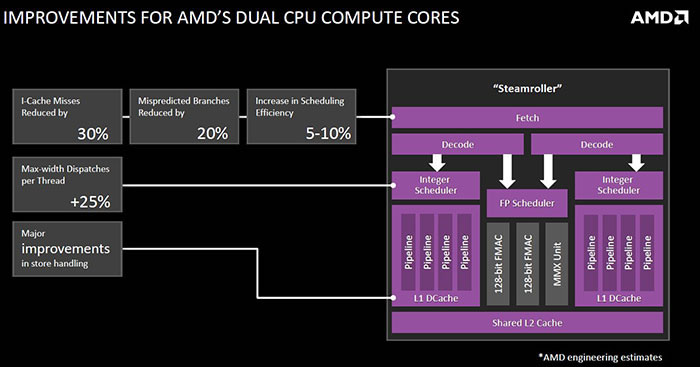
Steamroller is an incremental evolution of AMD's previous CPU architecture Piledriver. The fundamental topology that underpins Piledriver, a module-based design, is retained within Steamroller but efficiency improvements and performance tweaks have been shoehorned in.
The fetch-and-decode stages of the pipeline have been altered to boost throughput and reduce bottlenecks. This has been supplemented with a 50 per cent boost in the instruction cache, rising to 96KB, allowing so-called 'misses' to be reduced by up to 30 per cent. The task scheduler has also been revamped to deal with 48 entries compared to Piledriver's 40, allowing the CPU to process instructions more efficiently.
The combined effect of all these tweaks is around 10 per cent performance uplift over Piledriver in terms of instructions-per-cycle (IPC). That's a number you'd expect to see with the deliverance of a new CPU architecture. Sadly, the number isn't significant enough for AMD to close the ever-growing gap with Intel, whose latest Haswell architecture is leaps and bounds ahead of Steamroller.
GCN to the APU
The more notable update to Kaveri applies to its graphics segment. Kaveri is the first AMD APU to equip the company's GCN architecture, giving it the same core design and functionality as high-end graphics cards like the Radeon R9 290X.
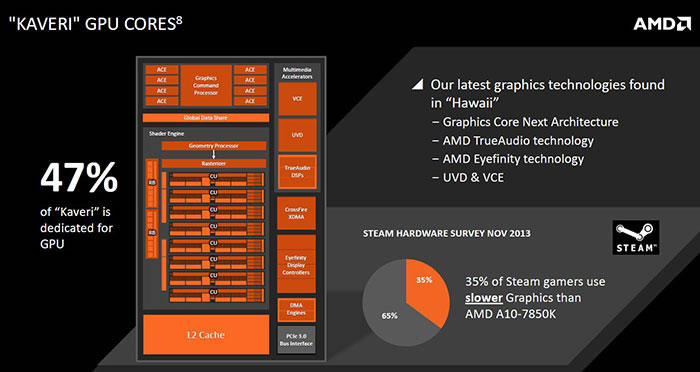
The flagship Kaveri APU, the A10-7850K, has about a quarter of the physical grunt of AMD's flagship R9 290X. The A10-7850K leverages eight compute units (CUs), each one filled with 64 shaders. In total that amounts to 512 GCN cores, equivalent to a HD 7750, and AMD claims Kaveri has up to 25 per cent more graphics performance than its predecessor, Richland. On average this number is closer to 15 per cent due to the lower graphics frequency.
The use of GCN graphics cores mean that Kaveri APUs are able to support AMD's TrueAudio technology as well as the improved integrated video encoding and decoding engines. Where the Kaveri APUs differ most from discrete GCN-based graphics solution is with regards to memory and how that is accessed. Unlike discrete GPUs which have onboard video memory, the APU's graphics component has to share system memory (RAM) with the CPU.
AMD's latest solution to dealing with this shared resource problem is called Heterogeneous System Architecture (HSA). This new technology gives the GPU the same level of system memory access that was previously limited to the CPU component. Such a move is pivotal for AMD's APU which places clear primacy on the GPU component. HSA cannot be implemented overnight, since it is something of a paradigm shift for programming. Existing code needs to be reconfigured, and the HSA consortium, of which AMD is a leading member, is currently reworking multiple programming languages to function on HSA architecture.
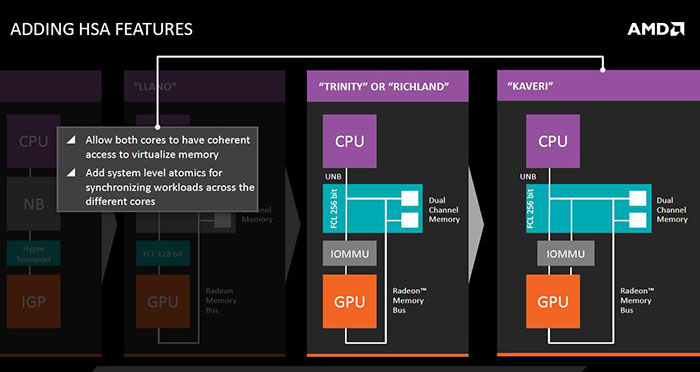
The pragmatism - models, socket, pricing, performance, etc.
Kaveri APUs make use of the existing FM2+ socket and are fully supported on all A88X, A85X and A78 chipset motherboards. Some lower-cost A55 motherboards also support Kaveri, but boards this cheap are better teamed up with more affordable Richland-based APUs.
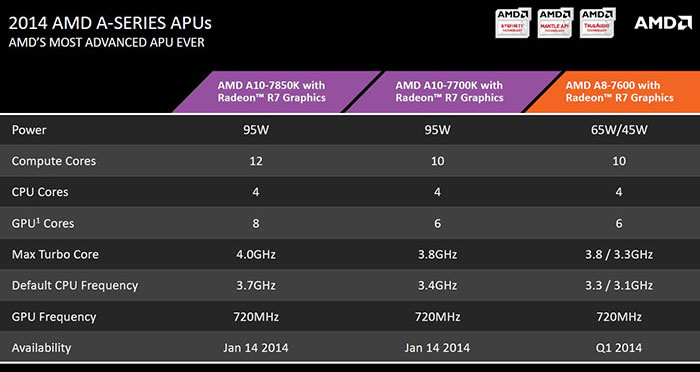
At launch, only AMD's flagship A10-7850K receives the full selection of graphics cores, the A10-7700K drops 128 of them. The CPU frequency is also downgraded on the A10-7700K but this can be corrected for by taking advantage of the unlocked multiplier that both K models possess. The A10-7700K comes in for only $21 less, and we feel most buyers would be better served with the A10-7850K.
Those with less-demanding needs, or looking to build a more compact system, are best served by the A8-7600. Priced at $119, and shipping in mid-2014, the A8-7600 appears to offer the best balance of price, performance and power consumption.
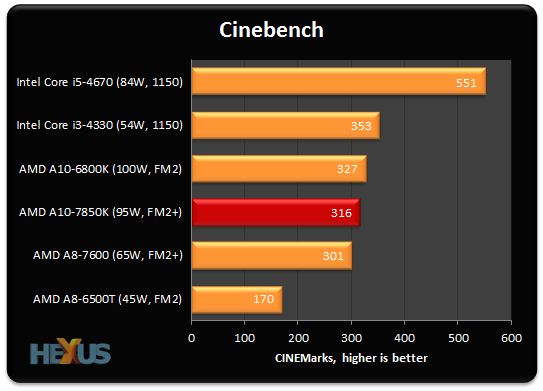
The overall picture for CPU performance shows the Kaveri APUs narrowly behind previous Richland APUs. Intel's Core i3 and Core i5 processors also hold a significant lead.
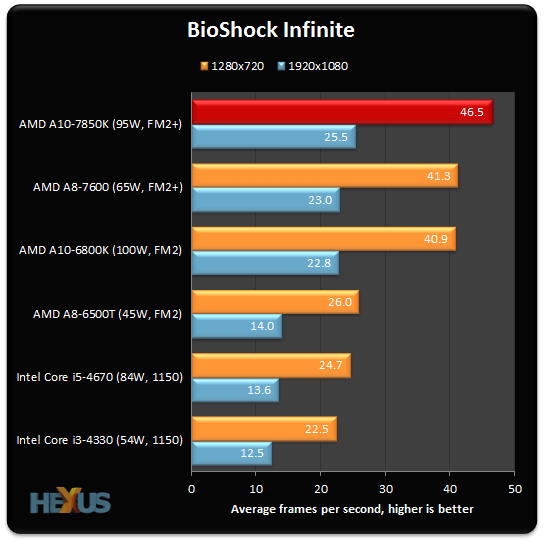
The saving grace for Kaveri comes with respect to gaming and other GPU-centric workloads. In most games the A10-7850K outpaces the previous flagship, the A10-6800K, by up to 20 per cent. The A8-7600 also does well to keep pace given its price. On average AMD's Kaveri APUs offer 1.5-2X the frame-rates of Intel's Haswell Core series processors using Intel HD Graphics.
Architecture wrap
With the last generation of APUs in mind it is clear to see AMD's Kaveri APUs represent a large step forward. The static CPU performance is balanced out with lower power consumption and a stronger GPU component that is capable of powering current gaming titles at 1080p with playable frame-rates. Other new technologies, like HSA, are nice but should be viewed as foundations for future APU designs.
As always, Scan Computers will be stocking the widest range of AMD APUs. Please head on over to here to see our listings.